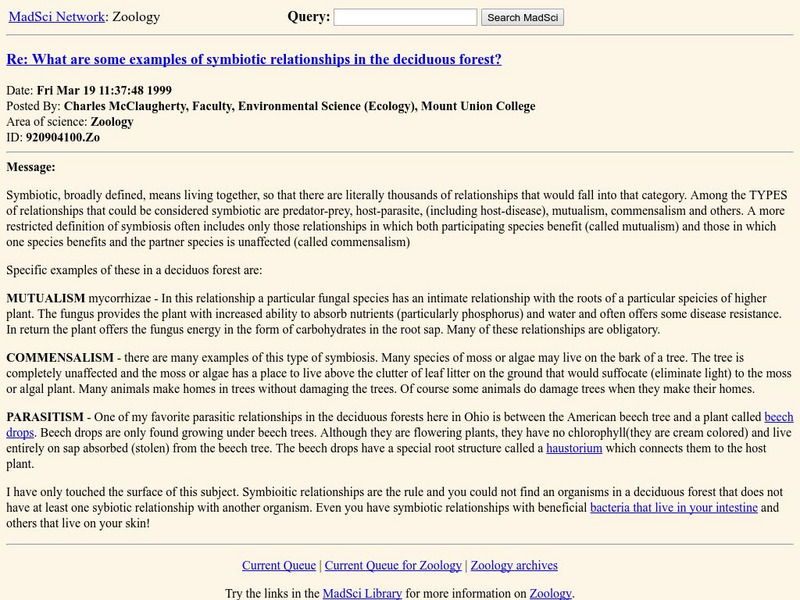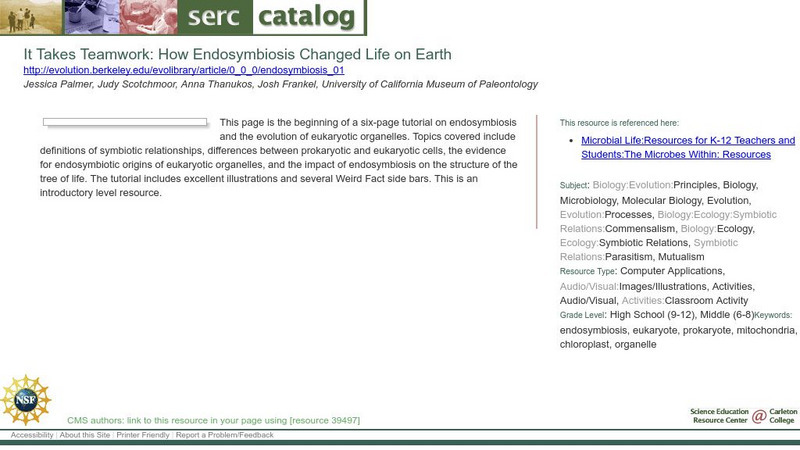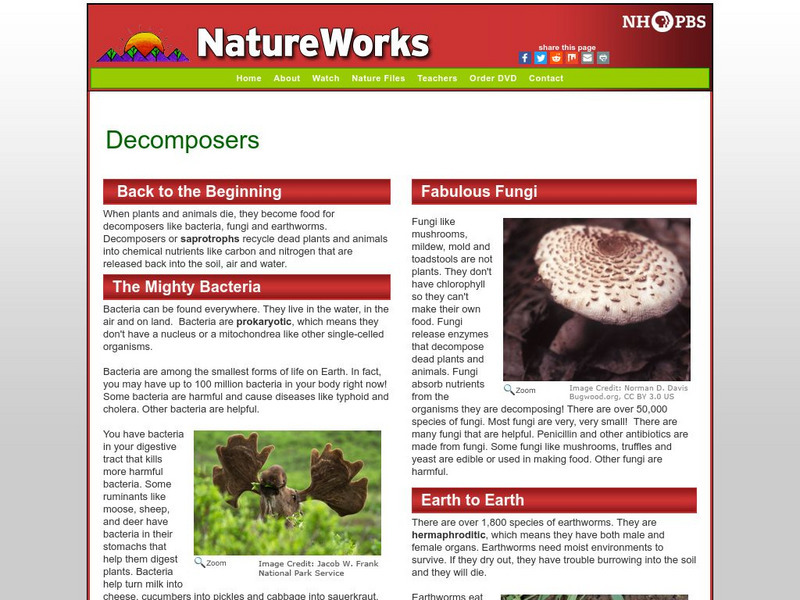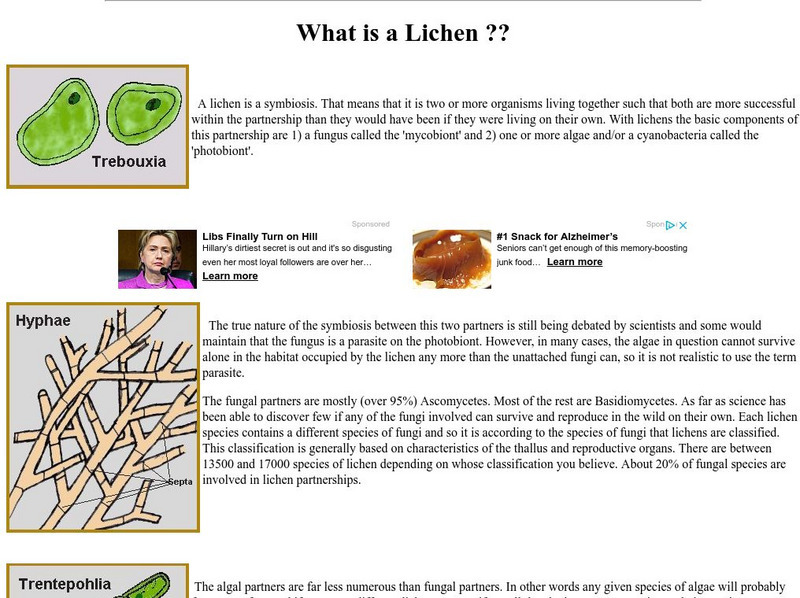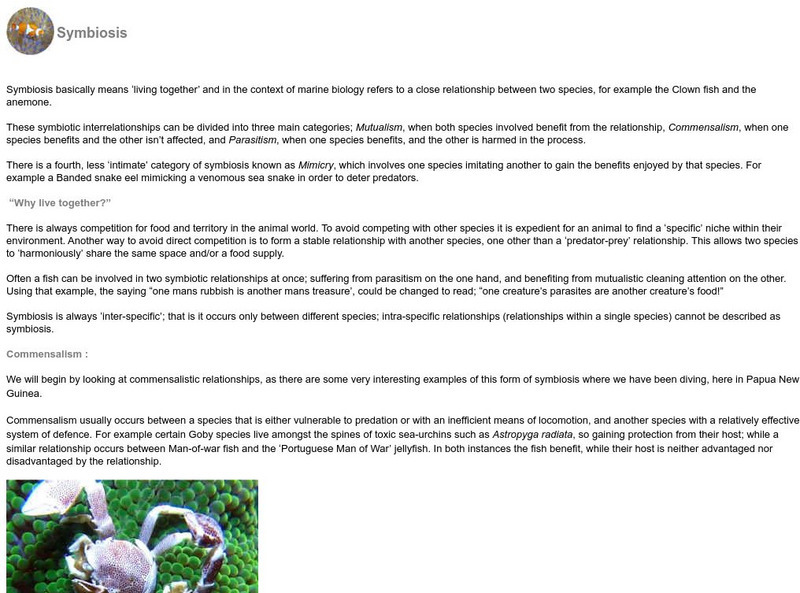Kentucky School for the Deaf
Levels of Organization within an Ecosystem
From tiny organisms to entire biomes, young scientists examine the interdependent relationships tying all living and non-living things together with this collection of ecology resources.
Science Struck
Science Struck: Symbiotic Relationships in the Deciduous Forest
Explains what a symbiotic relationship is, the five main types of symbiosis, and provides examples of symbiotic relationships among living things in a deciduous forest.
MadSci Network
Symbiotic Relationships in the Deciduous Forest
A brief definition of symbiotic, followed by explanations of mutualism, commensalism, and parasitism.
Science Struck
Science Struck: Symbiotic Relationships in the Desert
Describes three types of symbiotic relationships that can be found in a desert biome.
Science Education Resource Center at Carleton College
Serc: It Takes Teamwork: How Endosymbiosis Changed Life on Earth
A tutorial on symbiotic relationships that explores the differences between prokaryotic and eukaryotic cells as well as the origins of eukaryotic organelles possibly being from endosymbiotic relationship. This tutorial also offers...
University of Hamburg
University of Hamburg: Symbiosis & Normal Microbiota
A diagram of the different types of symbiosis. There are 4 examples of symbiotic relationships and explanations. Read this page and then give yourself a quiz.
Science Struck
Science Struck: Symbiotic Relationships in the Rainforest
Explains what mutualism, commensalism, and parasitism are.
Science Struck
Science Struck: Symbiotic Relationships in the Tundra
Explains what mutualism, commensalism, and parasitism look like in a tundra biome.
Science Struck
Science Struck: Mutualism Relationships
Learn how mutualism benefits the organisms in a symbiotic relationship and what the different types of mutualism are. Provides lots of examples.
PBS
Nh Pbs: Nature Works: Decomposers
This site gives a detailed overview of "decomposers": bacteria, fungi, and earthworms. Content includes a look at how decomposers contribute to a symbiotic relationship.
BiologyWise
Biology Wise: What Are Nitrogen Fixing Bacteria
Describes symbiotic relationship between leguminous plants and nitrogen-fixing bacteria. Explains the mechanism the bacteria use to fix nitrogen, the chemical formula involved, and different types of nitrogen-fixing bacteria.
Encyclopedia of Earth
Encyclopedia of Earth: Ecology: Lichen
Article describing the different categories of lichens, their physical features, how they reproduce, their evolution, and important benefits lichens provide to humans. (Published: July 19, 2010)
Earth Life
Earth Life Web: What Is a Lichen?
A Lichen is made up of two parts: a fungus and an algae or cyanobacteria. To find out more read about their morphology and who benefits from this symbiotic relationship.
Other
Marine Studies: Symbiosis
View graphics of a mimic octopus, frog fish, snake eel, hermit crab and clown fish. Discover how they form symbiotic relationships.
University of Utah
University of Utah: Genetic Science Learning Center: The Evolution of the Cell
Learn about the endosymbiotic theory. This theory explains the evolution of cells from a mitochondria and chloroplast working together in a symbiotic relationship to the current cell structure.
Science Struck
Science Struck: Examples of Commensalism
Describes examples of commensal relationships in the natural world.
Australian National Botanic Gardens
Australian Government: Fungi and Invertebrates
You will explore the symbiotic relationship that exist between different fungi and a variety of insects in this interesting site.
Other popular searches
- Symbiotic Relationships
- 5 Symbiotic Relationship
- Good Buddies Symbiotic
- Good Buddy Symbiotic
- Symbiotic Relations
- Symbiotic Interactions
- Symbiotic Relationshios
- Relationships Symbiotic Dog


